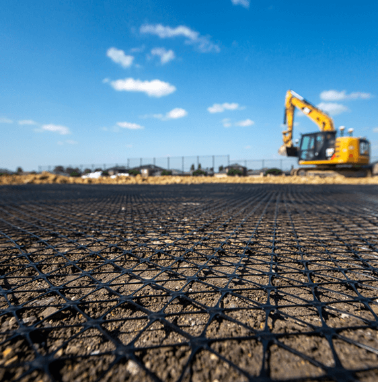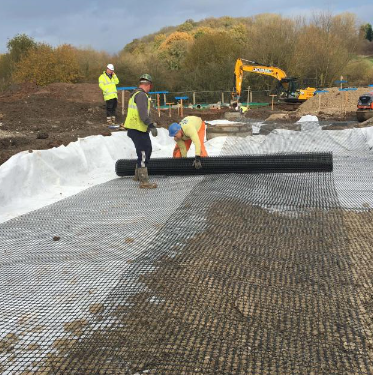- Understanding the Role of Geomembrane Liners in Waste Management
- Innovations in Geomembrane Liners for Water Management
- Geomembrane Liners: A Comprehensive Guide
- The Future of Geomembrane Liners in Civil Engineering
- Geomembrane Liners: Enhancing Landfill Stability
Manager:
WhatsApp:+86 177 0135 2670
Tel:+86 177 0135 2670
Email:marketing@okorder.com
Address:3rd Floor, No.2 Building, No.1 Sanlihe Road
How does a geogrid work?
Geogrids have changed the face of civil engineering by ensuring stability and durability in various structures like roads, embankments, retaining walls among other things. These innovative materials come in different types such as plastic geogrid, fiberglass geogrid and glassfiber geogrid and are used for different purposes. This article will look at how geogrid works, its different types and its application in various construction situations. Also, it will tackle why it is beneficial to purchase these materials from wholesale geogrid suppliers.

Understanding Geogrids
A type of geosynthetic material used mainly for reinforcing civil engineering projects. They are characterized by the open grid-like mesh that promotes interlocking of soil particles with other materials which improves strength and performance of buildings.
How Do Geogrids Work?
The main purpose of a geo-gird is to spread loads over a large area thus improving the integrity of the subgrade. The four mechanisms can be outlined as follows:
1. Interlocking: Because there are spaces on this gridded structure in filling up with granules of land – the main substance under investigation we don’t have here solid matter per se but only void space within which something might lie – these openings increase shear resistance against ground movement.
2. Load Distribution: Geogrids reduce pressure points by spreading out loads across a larger area rather than concentrating them into small spots which could lead to subsidence or instability if left unchecked.
3. Tensile Reinforcement: In most cases soils possess low tensile strengths; however geo-grid improves this situation making such soils more resistant towards failure forces.
4. Confinement: Grid like structure confines soil preventing any horizontal movement and safeguarding constructions from destruction.
Types of Geogrids
Geogrids may be classified according to their composition materials or fabrication techniques involved when making them . Most commonly found types consist of plastic geogrids, fiberglass geogrids and glassfiber geogrids.
Plastic Geogrid
Plastic geogrid is manufactured using polymers such as polypropylene or HDPE. Its popularity arises from its ability to last long, resilience against environmental degradation, flexibility among other advantages plastic geogrid can be best described for long term applications in road construction, slope stabilization and reinforcement of retaining walls and embankments.
Fiberglass Geogrid
Fiberglass made from woven yarns is the major component of fiberglass geogrid. They have high tensile strength and also are not prone to deformation even under heavy loadings. In asphalt reinforcement fiberglass geogrids play a vital role since they help prevent cracks on the pavement thereby increasing its lifetime. The fact that glass fiber materials do not expand when heated makes them ideal for regions with large variations in temperature.
Glassfiber Geogrid
Like their counterpart fiberglass, glassfiber geogrids are composed of glass fibers giving them immense strength and rigidity both being paramount qualities required for tough applications. Thus they find application where there should be low elongation coupled with high tensile strength- an example is airport runway construction or heavily loaded industrial structures.
Applications of Geogrids
Geosynthetic materials are widely used in building construction. Here the most common applications include;
Road Construction
In road construction process, geogrinds are used in reinforcing the sub base levels as well as base layers so that rutting and cracking can be prevented which will ensure smoother surface resulting into durable roads; these type is mainly characterized by its durability hence it’s always present during road constructions compared to others such as; plastic upon which fibreglass is commonly employed due to toughness together with longevity.
Retaining Walls
For Retaining Walls
Reinforcing the soil behind walls is a major role played by geogrids in construction of retaining walls. It holds back the soil and prevents it from being washed away during storms. The type of geogrid to use in this case, either plastic or glassfiber, depends on the specific needs of the project.
The main types of geogrid that are used for embankment stabilization are plastic, fiberglass, and glassfiber. Geo grids stabilize the embankment thereby reducing landslide incidences and settlement. Choice of geogrid for this purpose depends on loading and other environmental conditions.
Reinforcement of soils alongside slopes stabilizes them preventing erosion. In fact, they provide soil with extra tensile strength which results in an overall stable structure.
Benefits Of Purchasing Wholesale Geogrid
There several benefits associated with purchasing wholesale geogrid:
Lower Costs
Bulk purchase of geo grids from whole sellers has often resulted in significant cost cuts than their retail counterparts making such projects more economic viable.
Assured Quality
Regulated suppliers guarantee quality products that meet market standards ensuring that corresponding applications will be durable enough to serve clients’ objectives.
Widespread Availability
Most stockers have huge warehouses filled with geo grid so when need arises they can be obtained without causing delays as well as interruptions on any particular undertaking.
Tailoring Options
Nearly all wholesalers offer customizing opportunities whereby buyers can make orders depending on their specifications for example; different sizes, strengths and materials hence these services comes at a given price.

Conclusion
Modern civil engineering cannot do without such components like plastics, fiberglasss and glasses used for making geo grids. By contributing to land stability, carrying loads and making structures strong their presence is necessary in every construction site. Thus understanding how they work and choosing appropriate ones are key to success and sustainability within building works projects.
Besides cost savings through volume purchases, these manufacturers guarantee good quality and constant supply. For those involved in road making, retaining walls reinforcement, embankment stabilization or general soil reinforcement; geo grids provide the answer to any engineering needs.
Thanks to their unique properties that differ depending on the material type, different types of geogrids can be used by engineers to create more long-lasting structures.
-
2024-06-12Asphalt fiberglass geogrid construction plan
-
2024-06-04Asphalt fiberglass geogrid construction plan
-
2024-05-21What is the disadvantage of geogrid?
-
2024-05-21What is the lifespan of geogrid?
-
2024-05-21What are the 3 main uses of a geotextile?






